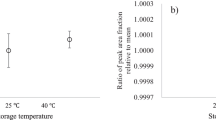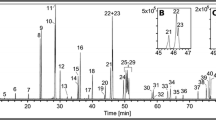Abstract
Quantitative nuclear magnetic resonance (qNMR) was used for the purity determination of neat compounds of persistent organic pollutants (POPs). qNMR is a unique quantitative method that is not only traceable to the International System of Units (SI), but it also does not require a standard of its own. The purities of the POP compounds determined in this work were traceable to a single certified reference material (CRM), which is extremely attractive for reference material producers. The purities observed by qNMR were equivalent to those observed by gas chromatography with flame ionization detection (GC/FID) or a differential scanning calorimetry (DSC) combined with a thermogravimetric analyzer (TGA). The uncertainties obtained by the qNMR method were comparable to being slightly larger than those observed by DSC.



Similar content being viewed by others
References
Wells RJ, Cheung J, Hook JM (2004) Accred Qual Assur 9:450–456
Griffiths L, Irving AM (1998) Analyst 123:1061–1068
Saito T, Nakaie S, Kinoshita M, Ihara T, Kinugasa S, Nomura A, Maeda T (2004) Metrologia 41:213–218
Al-Deen TS, Hibbert DB, Hook JM, Wells RJ (2004) Accred Qual Assur 9:55–63
Jancke H, Malz F, Haesselbarth W (2005) Accred Qual Assur 10:421–429
Malz F, Jancke H (2005) J Pharm Biomed Anal 38:813–823
Al Deen TS, Hibbert DB, Hook JM, Wells RJ (2002) Anal Chem Acta 474:125–135
Malz F, Jancke H (2006) Anal Bioanal Chem 385:760–765
Kupče Ē, Freeman R (1995) J Magn Reson A 115:273–276
Derome AE (1987) Modern NMR techniques for chemistry research. Pergamon Press, Oxford
Delsuc MA, Lallemand JY (1986) J Magn Reson 69:504–507
Pauli GF, Jaki BU, Lankin DC (2007) J Nat Prod 70:589–595
Coplen TB, Böhlke JK, De Bièvre P, Ding T, Holden NE, Hopple JA, Krouse HR, Lamberty A, Peiser HS, Révész K, Rieder SE, Roseman KJR, Roth E, Taylor PDP, Vocke RD, Xiao YK (2002) Pure Appl Chem 74:1987–2017
Wieser ME (2006) Pure Appl Chem 78:2051–2066
Coplen TB (2001) Pure Appl Chem 73:667–683
Saito T, Ihara T, Sato H, Jancke H, Kinugasa S (2003) Bunseki Kagaku 52:1029–1036
Acknowledgment
This work was supported by grants-in-aid from the Ministry of Economy, Trade and Industry, Japan.
Author information
Authors and Affiliations
Corresponding author
Rights and permissions
About this article
Cite this article
Saito, T., Ihara, T., Koike, M. et al. A new traceability scheme for the development of international system-traceable persistent organic pollutant reference materials by quantitative nuclear magnetic resonance. Accred Qual Assur 14, 79–86 (2009). https://doi.org/10.1007/s00769-008-0461-z
Received:
Accepted:
Published:
Issue Date:
DOI: https://doi.org/10.1007/s00769-008-0461-z




